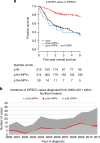Recommendations for determining HPV status in patients with oropharyngeal cancers under TNM8 guidelines: a two-tier approach
- PMID: 30890775
- PMCID: PMC6474272
- DOI: 10.1038/s41416-019-0414-9
Recommendations for determining HPV status in patients with oropharyngeal cancers under TNM8 guidelines: a two-tier approach
Abstract
Background: TNM8 staging for oropharyngeal squamous cell carcinomas (OPSCC) surrogates p16 immunohistochemistry for HPV testing. Patients with p16+ OPSCC may lack HPV aetiology. Here, we evaluate the suitability of TNM8 staging for guiding prognosis in such patients.
Methods: HPV status was ascertained using p16 immunohistochemistry and high-risk HPV RNA and DNA in situ hybridisation. Survival by stage in a cohort of OPSCC patients was evaluated using TNM7/TNM8 staging. Survival of p16+/HPV- patients was compared to p16 status.
Results: TNM8 staging was found to improve on TNM7 (log rank p = 0·0190 for TNM8 compared with p = 0·0530 for TNM7) in p16+ patients. Patients who tested p16+ but were HPV- (n = 20) had significantly reduced five-year survival (33%) compared to p16+ patients (77%) but not p16- patients (35%). Cancer stage was reduced in 95% of p16+/HPV- patients despite having a mortality rate twice (HR 2.66 [95% CI: 1.37-5.15]) that of p16+/HPV+ patients under new TNM8 staging criteria.
Conclusion: Given the significantly poorer survival of p16+/HPV- OPSCCs, these data provide compelling evidence for use of an HPV-specific test for staging classification. This has particular relevance in light of potential treatment de-escalation that could expose these patients to inappropriately reduced treatment intensity as treatment algorithms evolve.
Conflict of interest statement
Dr. Moran reports he is an employee of Pfizer UK Ltd. This employment has no relationship with the submitted publication. All remaining authors declare no competing interests.
Figures


Similar articles
-
How applicable is the TNM 8 staging for human papillomavirus (HPV) related oropharyngeal squamous cell carcinoma (OPSCC) to a UK population of 106 patients? : A cohort comparison of the TNM 7 and TNM8 staging systems for HPV positive oropharyngeal cancer in a UK population.Eur Arch Otorhinolaryngol. 2021 Mar;278(3):755-761. doi: 10.1007/s00405-020-06143-z. Epub 2020 Jul 3. Eur Arch Otorhinolaryngol. 2021. PMID: 32621245
-
Evaluation of the eighth TNM classification on p16-positive oropharyngeal squamous cell carcinomas in the Netherlands and the importance of additional HPV DNA testing.Ann Oncol. 2018 May 1;29(5):1273-1279. doi: 10.1093/annonc/mdy060. Ann Oncol. 2018. PMID: 29438466
-
Extracapsular extension of neck nodes and absence of human papillomavirus 16-DNA are predictors of impaired survival in p16-positive oropharyngeal squamous cell carcinoma.Cancer. 2020 Jan 1;126(9):1856-1872. doi: 10.1002/cncr.32667. Epub 2020 Feb 7. Cancer. 2020. PMID: 32032442
-
Comparison of Molecular Assays for HPV Testing in Oropharyngeal Squamous Cell Carcinomas: A Population-Based Study in Northern Ireland.Cancer Epidemiol Biomarkers Prev. 2020 Jan;29(1):31-38. doi: 10.1158/1055-9965.EPI-19-0538. Epub 2019 Oct 30. Cancer Epidemiol Biomarkers Prev. 2020. PMID: 31666283 Free PMC article.
-
Current Perspective on HPV-Associated Oropharyngeal Carcinomas and the Role of p16 as a Surrogate Marker of High-Risk HPV.Klin Onkol. 2019 Summer;32(4):252-260. doi: 10.14735/amko2019252. Klin Onkol. 2019. PMID: 31426640 Review. English.
Cited by
-
Identification of High-Risk Human Papillomavirus DNA, p16, and E6/E7 Oncoproteins in Laryngeal and Hypopharyngeal Squamous Cell Carcinomas.Viruses. 2021 May 27;13(6):1008. doi: 10.3390/v13061008. Viruses. 2021. PMID: 34072187 Free PMC article.
-
The Role of the p16 and p53 Tumor Suppressor Proteins and Viral HPV16 E6 and E7 Oncoproteins in the Assessment of Survival in Patients with Head and Neck Cancers Associated with Human Papillomavirus Infections.Cancers (Basel). 2023 May 11;15(10):2722. doi: 10.3390/cancers15102722. Cancers (Basel). 2023. PMID: 37345059 Free PMC article.
-
Explainable prediction model for the human papillomavirus status in patients with oropharyngeal squamous cell carcinoma using CNN on CT images.Sci Rep. 2024 Jun 20;14(1):14276. doi: 10.1038/s41598-024-65240-9. Sci Rep. 2024. PMID: 38902523 Free PMC article.
-
Identification of a Biomarker Panel from Genome-Wide Methylation to Detect Early HPV-Associated Oropharyngeal Cancer.Cancer Prev Res (Phila). 2024 Apr 2;17(4):169-176. doi: 10.1158/1940-6207.CAPR-23-0317. Cancer Prev Res (Phila). 2024. PMID: 38286404 Free PMC article.
-
Salivary High-Risk Human Papillomavirus (HPV) DNA as a Biomarker for HPV-Driven Head and Neck Cancers.J Mol Diagn. 2021 Oct;23(10):1334-1342. doi: 10.1016/j.jmoldx.2021.07.005. Epub 2021 Jul 27. J Mol Diagn. 2021. PMID: 34325059 Free PMC article.
References
-
- Amin MB, Greene FL, Edge SB, Compton CC, Gershenwald JE, Brookland RK, et al. The Eighth Edition AJCC Cancer Staging Manual: continuing to build a bridge from a population‐based to a more “personalised” approach to cancer staging. Cancer J. Clin. 2017;67:93–99. doi: 10.3322/caac.21388. - DOI - PubMed
-
- Brierley JD, Gospodarowicz MK, Wittekind C, editors. TNM classification of malignant tumours. Oxford: John Wiley & Sons; 2017.
Publication types
MeSH terms
Substances
Grants and funding
LinkOut - more resources
Full Text Sources
Other Literature Sources

